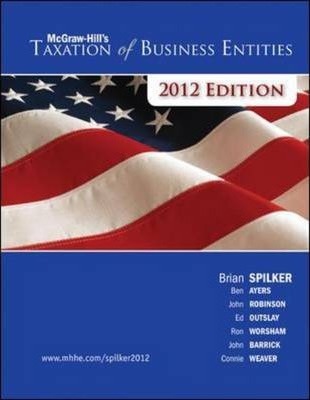
McGraw-Hill's Taxation of Business Entities 3rd Edition by Connie Weaver, Brian Spilker, Edmund Outslay, John Robinson, Ronald Worsham, Benjamin Ayers, John Barrick
Edition 3ISBN: 9780077924522
McGraw-Hill's Taxation of Business Entities 3rd Edition by Connie Weaver, Brian Spilker, Edmund Outslay, John Robinson, Ronald Worsham, Benjamin Ayers, John Barrick
Edition 3ISBN: 9780077924522 Exercise 1
Describe the two limitations placed on the calculation of the domestic product activities deduction and explain the apparent reason for each limitation.
Explanation
Domestic Production Activity Deduction (DAPD):
Domestic Production Activity Deduction (DAPD)refers to the excess deduction allowed by IRS to promote domestic production.This is allowed for the tangible product which has been produced, manufactured, or grow entirely or partly inside US.The DAPD allowed is 9% of lesser of (1)The business taxable income before deduction (or modified AGI)or (2)qualified production activity income.
There are two limitation imposed for DAPD.Firstly, the deduction is limited to the taxable income of the business so that an entity could not take undue advantage to the privilege.
Second, the deduction has been further restricted to the income generated from such activity, it encourage entity to generate income from such business activity.
Domestic Production Activity Deduction (DAPD)refers to the excess deduction allowed by IRS to promote domestic production.This is allowed for the tangible product which has been produced, manufactured, or grow entirely or partly inside US.The DAPD allowed is 9% of lesser of (1)The business taxable income before deduction (or modified AGI)or (2)qualified production activity income.
There are two limitation imposed for DAPD.Firstly, the deduction is limited to the taxable income of the business so that an entity could not take undue advantage to the privilege.
Second, the deduction has been further restricted to the income generated from such activity, it encourage entity to generate income from such business activity.
McGraw-Hill's Taxation of Business Entities 3rd Edition by Connie Weaver, Brian Spilker, Edmund Outslay, John Robinson, Ronald Worsham, Benjamin Ayers, John Barrick
Why don’t you like this exercise?
Other Minimum 8 character and maximum 255 character
Character 255


